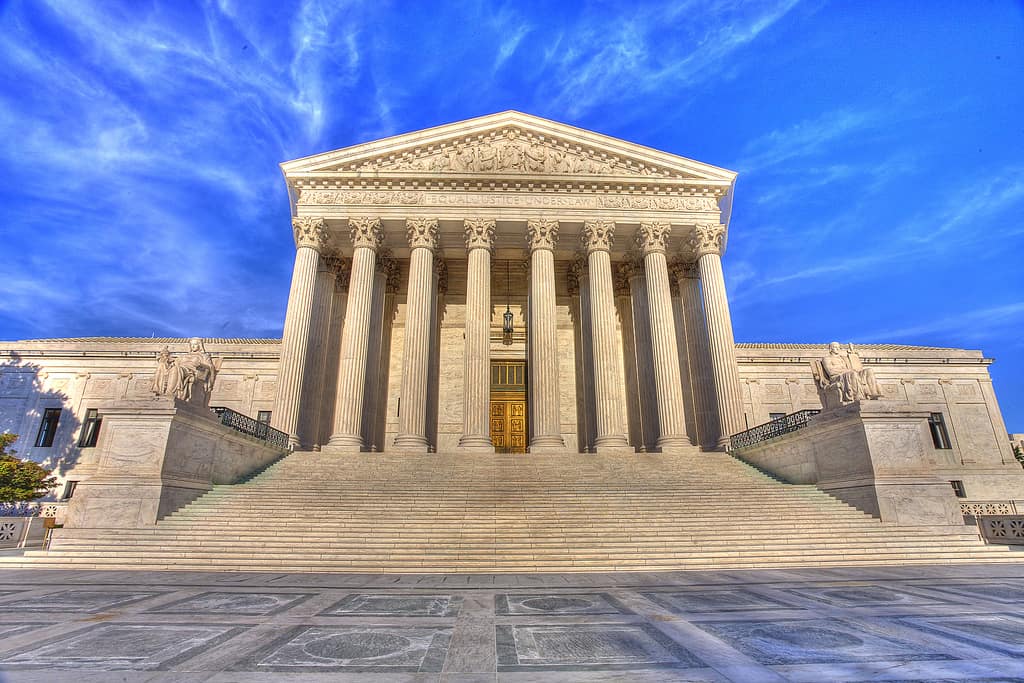Perhaps the biggest decision released by the Supreme Court at the end of its 2016-17 term this past week came not in a final decision, but in an interim order. On June 26, the Court issued an unsigned “Per Curiam” order covering several cases under the name Trump v. International Refugee Assistance Project. 1 In that order, the Court announced that it would hear the President’s appeals in regard to his besieged “travel ban.” It also announced it would allow some of that ban to go into effect, while other parts would remain temporarily blocked. In the formal language of the Court, it had decided to grant the President’s petitions for certiorari, and to to grant in part his applications for a stay.
These are the types of decisions the Court makes routinely. Ordinarily, they are hardly worth commenting on, even in high profile cases. This decision, though, has been anything but. Much of this comes from the fact that the Executive Order challenged in this case is one, if not the, major policy initiative of the President. Given the high political drama, it is no wonder that what is usually a routine judicial decision has become a major media event.
Beyond that, though, this decision by the Court is somewhat unusual on its own merits. This has to do with both the frankly strange nature of the order entered by the Court, along with some complicated aspects about the underlying case itself.
***
The Stay: Although the Court grants stays of lower court decisions with some regularity, especially when deciding to consider an appeal, this particular stay is formulated oddly. The underlying case emerges in the context of a preliminary injunction. In other words, the lower courts stopped the President from enforcing his Executive Order while litigation was pending. A Supreme Court stay blocks the orders blocking the Executive Order. Rather than simply allowing the lower courts’ orders to stand or fall, the Court here decided to block some, but not all, of the Executive Order. In short, the Court blocked enforcing the order as regards foreigners who have some bona fide relationship to the United States, whether family, professional, academic, etc., while allowing the travel ban to be enforced against anyone who lacks those ties.
What is weird is not the apparent compromise at the heart of the order. In fact, whatever one’s opinion of the travel ban itself, the order reads like a reasonable compromise a functional political system might actually produce. The Court, however, does not usually operate in that way. If the appeal has a good chance of success, the lower court decision ought to have been put on hold. Otherwise, the lower court decision should go into effect. Setting up a stay in this manner is rarely done. Still, as the Court noted in its Per Curiam opinion, the goal at this stage is to balance the needs of both parties while litigation is pending.
Moot: Another odd element is the prospect that this is all possibly for nothing. A court only hears actual “cases and controversies.” That is, a court only resolves problems that have not been resolved by themselves. Sometimes a case settles, and the court moves on. Sometimes a case does not settle but the facts change so that there is no more controversy. Child custody disputes, for example, cease to be issues for courts when the child turns 18. Here, there is a question about whether the Executive Order will be obsolete before the court hears arguments in October.
The Executive Order’s major official purpose was to provide time for the government to review immigration policies from the affected countries and make any changes necessary. Thus, the official reason for the ban was to give the appropriate agencies time to review and make changes; this is why many of the provisions were, on their face, only temporary. The Court has allowed this review to take place and, in fact, even acknowledges that it will be complete well before argument. “Given the Government’s representations in this litigation concerning the resources required to complete the 20-day review, we fully expect that the relief we grant today will permit the Executive to conclude its internal work and provide adequate notice to foreign governments within the 90-day life of s. 2(c).” [Slip. Op. at 12-13.]
If that is the case, then the whole rationale for the ban will itself have passed. It is possible, perhaps even likely, that the President will attempt another version of the ban after this review is complete. However, we would expect that if he does so, the results of the review will be part of the rationale for the ban. Shouldn’t the Court wait to see those results and whether they support or weaken the rationale for the ban? It may very well be that the Court wants to resolve the case in order to give the Trump Administration, Congress, and the States guidance on just what is acceptable when trying to limit immigration. Yet, to repeat, their ordinary course of action is to avoid handling purely advisory questions.
Refugees: The final point concerns the treatment of refugees by the Court. Its order treats them the same as all other persons seeking to come to the United States. That is, those from the banned countries with bona fide ties to the US will not be subject to the ban, while those without such ties will. While this distinction might make sense in the ordinary immigration framework, where the law routinely favors certain classes of relationships over others, for example preferences for close family members over distant relations, it does not make sense in the context of refugees.
Unlike ordinary immigrants, who move to be close to family, to seek better job opportunities, or to pursue academic development, refugees are fleeing to avoid death or grave persecution. They are fleeing for their lives. When dealing with ordinary immigrants, we evaluate their connections to the US in order to determine if they should be admitted. When dealing with refugees, we deal instead with the question of have they been persecuted, do they fear persecution, will they be subject to persecution, torture, or death. It is a humanitarian intervention, first and foremost. Our obligations to refugees, moreover, stem from treaty obligations and a dedication to protecting those unable to protect themselves. It is unfortunate that the Court did not recognize this fundamental distinction.
***
We do not know what the Court will ultimately decide in regards to this case. At some level, it is clear the justices thought that there was merit to both sides of the case, as we can see from the peculiar stay decision. Hopefully, the Court’s final opinion can provide some guidance that will help all parties seek a just immigration reform.
***
Image courtesy FlickrCC user MitchellShapiroPhotography.
- “Per Curiam” opinions are made “by the court” without any specific judge being the official author. ↩


